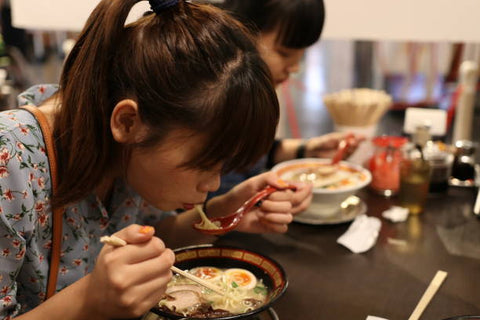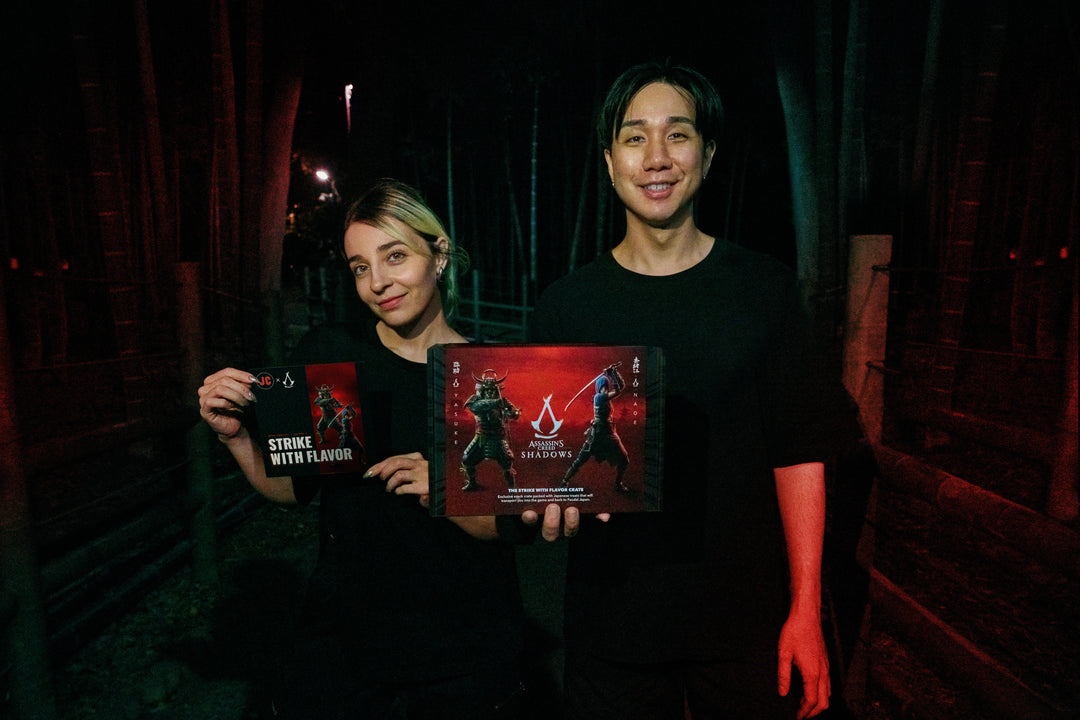Is Japanese Ramen Good For You?

Japanese ramen is undoubtedly among the most well-liked meals in the world. Japanese ramen will automatically come up at some time when discussing Japanese cuisine. Noodles have been prepared in a variety of ways for hundreds of years as one of the staple cuisines in Japan. A variety of noodle varieties, as well as the customs and etiquette that go with them, have evolved over time.
There are so many Japanese dishes using noodles available that it is difficult to grow tired, from Japanese udon noodles to buckwheat noodles to Japanese ramen and various varieties of Japanese noodle soup. The urge to learn more about this traditional Japanese delicacy has only grown as Japanese noodle dishes become popular over time. But, are these Japanese ramen good for your health?
What are Japanese Ramen Noodles?

Ramen is a dish that is popular in many places in Japan. It is regarded as a traditional Japanese dish, and many foreign visitors to Japan include eating ramen on their to-do lists. Ramen has also appeared in numerous Japanese anime and motion pictures. This dish is a cuisine all over the world because of the unique combination of rich flavors and chewy textures it offers. Shoyu, Miso, Shio, and Tonkotsu are the four essential tastes of ramen, and these are also the most popular ramen flavors.
Moreover, there are countless regional variations within these four basic flavors. Tonkotsu bases and miso are both common ingredients in Sapporo ramen. Local favorites, corn, and fish, are among the toppings. Hakata-style ramen, which is popular in Fukuoka, is distinguished by its pork bone broth, straightforward toppings, and the practice of kaedama, or refilling your noodles while your soup is still hot. The fun of eating ramen is noticing the small details, such as how firm the noodles are and how the onions are chopped.
Is Japanese Ramen Healthy?

Ramen is not typically considered a "healthy cuisine" in Japanese restaurants for several reasons, including the quantity of white flour-based noodles it includes per serving, making it extremely starchy and detrimental to blood sugar control. Second, the broth, which is normally somewhat salty, may contain some extra fats.
Many Japanese women avoid ramen of any form, especially the incredibly rich tonkotsu made with pork bones. Many Japanese people consume all the soup while slurping noodles, but they view the stock as more of a sauce and refuse to drink the soup base leftover because they find the liquid too salty and fatty to consume alone.
Thus, Japanese ramen has high fat, carbohydrate, and sodium content, just like most noodle foods. It poses a major risk of weight gain due to its high-calorie content. However, as long as you are mindful of how many calories you consume each day, you can eat one or two average-sized bowls of each meal.
Are Instant Ramen Noodles Healthy?

Wheat flour, a variety of vegetable oils, and flavorings are used to make the packed, instant kind of noodles known as "ramen." The noodles are pre-cooked, which means they have been steamed and then air-dried or fried to shorten the cooking time for consumers. You can buy instant ramen noodles in cups that can be microwaved after being dipped in water or in packages that come with a little packet of flavoring. The instant ramen noodles are made in a pot of salted, boiled water. The noodles are commonly a go-to dish for college students living in residence halls because they can also be made in a microwave. Without a doubt, ramen noodles are tasty and convenient, but further study is needed to determine how nutritious they are.
To make instant ramen noodles more nutrient-dense, wheat flour is fortified with synthetic versions of many minerals, including iron and B vitamins. They lack a number of important nutrients, though, including high-quality protein, fiber, vitamins C, A, and B12, as well as calcium, magnesium, and potassium. Additionally, compared to real ramen and some healthful dishes, manufactured foods like instant ramen noodles lack antioxidants, which offers a variety of health benefits.

Furthermore, the salt content of a single serving of instant noodles per 100g can range from 397 to 3678mg, occasionally even more. While sodium is a necessary mineral for your body to function properly, too much sodium intake can be harmful to your health. Also, MSG, a highly common chemical in many processed foods, is included in instant noodles. Despite the FDA's approval for consumption and its widespread use in numerous food types, there are worries about both its immediate and long-term effects on the body.
Can You Eat Japanese Ramen When Pregnant?

Given how easy they are to make and how satisfying they are, it is understandable why so many pregnant women want ramen noodles. Luckily, it is safe to eat Japanese ramen even when pregnant.
However, if you're expecting, some toppings, like raw fish or bean sprouts, frequently used on ramen bowls, might not be suitable for you. Thus, watching what you put in your ramen while pregnant is crucial.
Furthermore, the toppings determine whether eating Japanese ramen is safe or not, as they can frequently be created with ingredients not recommended for pregnant women, such as raw salmon, fish stock, bean sprouts, raw eggs, and others. So, it is recommended to stick to Japanese ramen that is prepared with proteins like beef and shredded chicken when eating ramen.
Nutrition facts of the Best Japanese Noodles
1. Shoyu Ramen

Shoyu ramen is a type of ramen with a soy sauce broth. It also has a strong sour flavor in addition to rich umami qualities, sprint noodles, and various toppings. As one of the mainstay styles of ramen, Shoyu draws its name from the tare seasoning that provides it with that base layer of taste. Shoyu, which translates as "soy sauce" in Japanese, is one of the main ingredients of this cuisine. The ramen broth is flavored with soy, which provides the soup with a rich, nuanced, and intensely umami flavor.
Pork and noodles make up most of the calories in a bowl of shoyu ramen. The total calories vary depending on the type of pork you use, the number of carbohydrates in the noodles, and the type of broth you use. Nutrition facts of Shoyu ramen are:
• Total Calories: 780
• Fat: 29 grams
• Carbohydrate: 58 grams
• Protein: 62 grams
2. Miso Ramen

Despite the dish's many local and global variants, miso is still used to flavor the original recipe. This miso paste has a salty, almost meaty flavor derived from fermented soybeans. The texture of miso ramen is rich and smooth, and it contains the familiar acidic saltiness of fermented soybeans. Miso thickens the soup a bit because it is a paste, making it a little bit more filling than the Shio ramen broth, which is thinner.
The chashu pork, the chili oil, and the ramen noodles make up most of the calories in this dish. Miso ramen is unexpectedly low in calories and has much nutritional value. Nutrition facts of Miso ramen are:
• Total Calories: 596
• Fat: 16 grams
• Carbohydrate: 69 grams
• Protein: 53 grams
3. Shio Ramen

Shio is renowned for having relatively fewer ingredients and being easier and quicker to prepare. Sea salt, the ideal salt to flavor chicken broths and sauces, is used to flavor shio ramen. The sea salt in the chicken stock doesn't overshadow it, allowing the clear broth base and toppings to stand out on their own.
Shio ramen broth is thinner and lighter in consistency than other types. The sea salt absorbs moisture from various flavors, bringing out the extremely rich, subtle flavors of all the other components. Additionally, it serves as a taste enhancer, removing the need for additional seasonings. Shio ramen's main source of calories is the thinner broth with fattier pieces of meat and more oil. Nutrition facts of Shio ramen are:
• Total Calories: 950
• Fat: 35 grams
• Carbohydrate: 111 grams
• Protein: 48 grams
4. Tonkotsu Ramen

Because it is a sort of broth and not a flavor, tonkotsu is a special form of ramen. Tonkotsu translates to "pork bone," refers to the broth created by simmering pork bones with some herbs for a long time to produce a creamy, milky white, fatty soups. Because the pork broth is so thick and because that is how it is traditionally prepared in the original location, tonkotsu ramen has much fewer toppings.
Tonkotsu doesn't need the fattier pieces of lean meat to make the dish more satisfying because the broth is thicker. You might attempt to produce chashu instead with thinner slices and yet have the same deep, velvety flavor. Nutrition facts of Tonkotsu ramen are:
• Total Calories: 656
• Fat: 32 grams
• Carbohydrate: 62 grams
• Protein: 49 grams
How to Make Japanese Ramen Healthier?

Most ramen served in Japanese restaurants has between 450 and 600 calories. The total calories range from 400 to 550 if you don't drink the entire pot of soup (saving more than 50 calories). But ramen comes in a wide variety. Every bowl is unique. When combined with other ingredients to make a balanced meal, ramen noodles are at their healthiest. Ramen noodles can be incorporated into a diet that emphasizes innumerable health by combining various ingredients.
A lot of vegetables like green onions, carrots, bamboo shoots, spinach, broccoli, zucchini, cauliflower, and peppers can provide a decent supply of vitamins, minerals, and fiber with each bite. In addition, high-quality protein, such as lean pork, eggs, or tofu, can make ramen healthier than the typical bowl of ramen ordered at a restaurant.
Furthermore, by experimenting with various vegetable combinations, find the ramen taste combination you prefer. By including some protein in your ramen, you can balance your meal. Choosing the same meat as the ramen taste is the simplest place to start. For the necessary protein, ramen bowls always work well with chicken, beef, fish, or pork. Without adding much oil, including chicken and vegetables offers vitamins and protein.

Even though there are about 200 calories in each serving, there are just 4.5 grams of fat and less than 2 grams of saturated fat. Adding veggies and lean meats gives the meal more bulk and can heighten feelings of fullness. This makeover also boosts the fiber from 1 gram to approximately 2.5 grams and adds loads of vitamin A, lutein, and B vitamins. Discover the options and learn how simple it is to quickly turn a bowl of ramen noodles, which already tastes great, into an incredibly nutritious, delectable dinner.
Ramen is neither healthy nor bad in and of itself. There are many other ways to prepare ramen noodle soup, including using chicken or shoyu (soybean) broth, thinly sliced cooked pork or chicken, additional veggies, various mushrooms, and even chili powder to provide a little heat. How you cook those ingredients and what additional things you mix them with counts. If done properly, it is also filling and delicious. Buy ramen from the Sugoi Mart noodles collection. You'll surely like every noodle available at Sugoi Mart. Shop now!
It's Japan Crate Time!
Japan Crate has the best and most limited Japanese items you'll surely love for a very affordable price. At Japan Crate, we make it simple for every customer to buy snacks and a variety of things from Japan. You won't need to wait longer than a week for that Japanese product you order online. Delivery and shipping options from Japan Crate are efficient and trustworthy around the world.
Experience a box of tasty Japanese treats delivered to your home each month! Japan Crate will add spice to your life with the best snacks, sweets, and collectible items in Japan. Just click the link above to sign up right now. Japan Crate will bring you the taste of Japan in no time!
Author Bio







Leave a comment